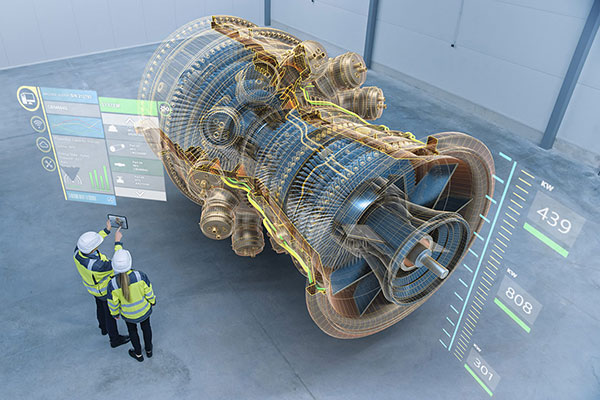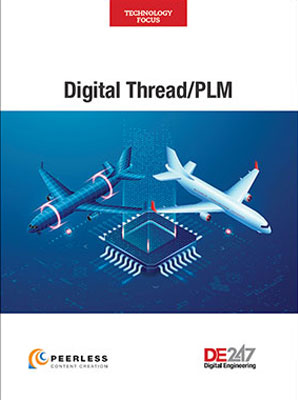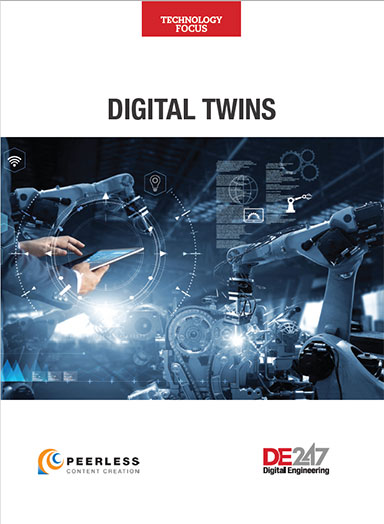Digital Twin’s Evolving Footprint
Keep an eye on key technologies and on the tighter linkage of the physical and digital worlds.

Fig. 1: Digital twins of electric drives can act as virtual sensors, monitoring the health and remaining useful life of components in the systems. The digital twins can also be used to explore what-if scenarios and support predictive maintenance. Image courtesy of Ansys.
Latest News
December 9, 2022
For a clear picture of how digital twin technology will evolve over the next few years, don’t look for radical change or shiny new technologies. Instead, take a good look at all of the technological components that provide the foundation for digital twin technology.
Then you will see an array of the key technologies, a steady expansion of digital twin capabilities, and a tighter link between the physical and digital worlds. The new and improved versions of digital twin to emerge will be less about dramatic changes and more about the establishment of a robust foundation that an organization can grow and thrive in as it adapts to continual change and unforeseen challenges.
Real change will spring from the maturing and tailoring of a combination of technologies, such as high-performance computing, artificial intelligence (AI)/machine learning (ML), extended reality and other emerging technologies. These technologies will shape and drive digital twins by enabling greater use cases, accuracy and capability.
As powerful as these components are, however, they themselves are still in their formative years. “AI and ML still have quite a way to go before they are commoditized and more accessible to the masses, and we are still in the very early days of mixed reality headsets and reality capture devices,” says Dan Isaacs, chief technical officer of the Digital Twin Consortium.
To a large extent, developers are still trying to figure out how to tailor these core components to fit into digital twin platforms so they help the virtual technology achieve its full potential.
“The concept of a digital twin isn’t necessarily new, but what has changed recently is that many of the underlying ingredients are maturing into mainstream workflows,” says Anthony Rowe, chief scientist at Bosch Research.
It’s no surprise that most products are designed in a digital format now. “Sensors are getting smaller, cheaper, lower power and more accurate,” Rowe says. “Computers are becoming more capable in terms of complex simulation, and we now have much more capable AI/ML techniques to draw complex inference and better forecast trends.”
Making Digital Twins More Complete
Practically, this means that the digital twin is moving closer to providing a consummate model of the products or processes it represents (Fig. 1).
“As digital twin technology continues to evolve, we can expect an increasingly comprehensive digital twin of the real world, with ever-improving fidelity and faster runtimes for simulation and analysis models,” says Dale Tutt, vice president of industry strategy at Siemens Digital Industries Software. “These comprehensive digital twins will increasingly include all cross-domain models, such as mechanical CAD or CAE, software code, electronics and bills of process and materials, including manufacturing data.”
Fundamental Changes in CAD/CAE
Beyond providing more comprehensive models, future digital twins will enable maturing technologies to push the limits of modeling and simulation.
“With the help of AI and machine learning models, digital twins will allow simulation of increasingly complex variations, reducing risks to end users, supporting more collaborative work and enabling formerly sequential steps to be parallelized,” says Brian Harrison, senior director of Omniverse digital twins at NVIDIA.

Equally important, the expanded roles of AI and other advanced technologies in the digital twin promise to recast today’s CAD and CAE software from basic tools to true design assistants that autonomously explore the design space.
“Engineers will take on the role of orchestrators, defining parameters and examining results as AI generates preliminary designs, helping engineers to work more efficiently, explore more design options and create higher performing products and systems,” says Tutt.
“To power this, simulations are growing more sophisticated and must rely on increasingly powerful computers and advanced AI to run,” Tutt says. “AI itself can help to not only manage the rising number of parameters in generative design and simulation but also support the creation of reduced order models, helping to run faster simulations, capture design knowledge and widen the design space.”
Shrinking Role of Physical Prototypes
As digital twin and CAD/CAE software grow more powerful and accurate, the need to physically prototype a product will likely diminish. The technology exists today to create a digital twin accurate enough to replace early-stage prototypes. As digital twin fidelity increases, physical prototypes may be necessary only for final product verification and validation, which could save companies significant time and money.
“Digital twin prototypes provide the ability to test iteratively and use synthetic data to enrich simulation when representative real-world data is not complete,” says Isaacs. “We will continue to see increased levels of automation in areas of composition, design, development and implementation. AI will continue to play a key role including areas of self-correction, which can be considered part of the automation.”
Building on Twin’s Superpowers
As digital twins deliver greater accuracy and faster simulation in the virtual world, twin’s impact will increasingly extend beyond the design and manufacturing stages into the physical product’s operating life, creating feedback loops that enable ongoing design improvements and support new product innovations.
For this to happen, however, the digital twin must have closer, more comprehensive ties to the physical world. Now, digital twins are increasingly tapping the rich data trove of the Internet of Things (IoT).
“Virtual worlds and digital twin simulations will require multiple data-stream inputs—from the physical world and from AI agents operating in the virtual worlds,” says Harrison. “These data streams will increasingly come from IoT devices, sensor models, human and robot interaction, environmental data, CAD or 3D design tool ecosystems, physics simulators and industrial automation tools.”
This meeting of the virtual and the physical worlds provides all of the necessary ingredients to improve and even extend the design and development process.
“By studying the digital twin under actual working conditions, companies can see the product in action, over time, when subjected to the physical environment,” says Sameer Kher, senior director of R&D digital twin at Ansys.
This allows the product development team to close the loop on its initial simulations, and enables engineers to make more informed choices for future designs. The more digital twins can draw from richer and more accurate and comprehensive data troves, the more accurate their simulations and designs will be.
“If we link the digital and the physical worlds, the two manifestations will be able to evolve with each other,” says Harrison. “We can capture data from the real world through IoT sensors and devices and feed it into the digital model, keeping the twins in sync.
“Applying accurate physical simulation to the digital twin produces incredible superpowers,” Harrison adds. “Users can teleport to any part of the digital twin and inspect any aspect of it reflected from the real world. The next step in the evolution of this connection is the ability to create an operational digital twin that synchronizes input from real-world sensors with the digital twin and provides feedback or control back to the physical devices in real time.”
Cashing in on Operational Visibility
As digital twins increasingly leverage IoT data and optimize the operational visibility derived from virtual-physical world feedback loops, they are able to bring more and more predictive power to bear on a growing variety of applications. One area where companies can apply these capabilities is the management of maintenance and warranty expenditures.
Leveraging this operational visibility—combined with AI/ML-enhanced analytics—digital twins help companies to holistically understand and measure what’s happening in a part, subsystem, product or process by combining multiple data sources.
“Digital twins enable true predictive maintenance,” says Ansys’ Kher. “Instead of over-servicing or over-maintaining all types of assets to avoid costly downtime, repairs or replacement, companies can act just in time to address any product-performance issues. They can accurately visualize exactly when and where maintenance is needed, instead of making blind guesses and safe bets (Fig. 2). The time and cost savings here are substantial. Enterprises of all sizes and types can eliminate unnecessary maintenance using digital twins, bring an end to product downtime, reduce repairs and minimize warranty expenses.”
In some cases, adoption of digital twins and enabling technology has in some use cases resulted in a reduction of operating costs by as much as 30%, according to the Digital Twin Consortium.
With the movement from predictive maintenance to more prescriptive maintenance, unplanned downtime can be significantly reduced and eliminated. Understanding the system operation at the discrete, or atomic, component level enables greater understanding and opportunity to extend the life of the asset.
Keep in mind that these are still digital twin’s formative years; enhanced maintenance practices are still gaining momentum.
“We are going to see more and more unique digital twins that correspond to unique assets in the field and have real streaming data feed those digital twins so precautionary measures can be taken to make sure they are performing optimally and don’t fail,” says Keshav Sundaresh, global director of product management, digital twin and model-based systems engineering at Altair.
Centers of Change
The vanguard of digital twin’s evolution centers on two areas. Both are essential for the virtual technology to achieve its full potential.
The first is an obvious area of concern that focuses on the twin’s ability to contend with the growing trend of products becoming smarter, more complex and more interdisciplinary.
“This combination will require tighter couplings between all engineering and process domains, even those that have not traditionally interfaced,” says Tutt. “Autonomous vehicles are a good example, in which cutting-edge electronics, semiconductors, software, AI/ML, mechanical and other domains must work together to create a vehicle that can drive autonomously.”
The second hot spot of change involves AI. The biggest changes will be manifested in the use of AI to build learning models and to synthesize data. This will enable the improvement of existing state models, as well as the creation of new, unforeseen ones (Fig. 3).

“An AI-enhanced digital twin may not just simulate different scenarios but suggest alternatives, based on optimization parameters set by the operators,” says Harrison. “The processing power required may grow at increasingly higher rates, which is where optimized data centers with better power consumption to processing factors will ensure that output does not increase their carbon footprint. These data centers, of course, will harness their own digital twins and complex simulations to achieve these goals.”
Enhanced by the advances in the use of AI, digital twins are expected to adopt more aggressive approaches to analysis and simulation.
“Digital twins will move from being directed to being more active, goal-seeking and anticipatory,” says Isaacs.
Isaacs explains how a recent paper by Dr. Grieves on the evolution of Digital Twins titled “Intelligent Digital Twins and the Development and Management of Complex Systems” (bit.ly/3t8s3RP) describes how digital twins are moving to the intelligent digital twin and the concept of “front-running simulation,” where the digital twin is running faster than real time ahead of the physical entity, effectively using real-time data to anticipate future outcomes. According to the paper, “In the ideal situation, the intelligent DTI [digital twin instance] will predict the adverse condition and intervene to prevent it from happening.”
These future outcomes for digital twins promise to benefit a number of use cases. These are expected to include:
- Upfront holistic performance optimization
- Prediction of real-world performance of multidisciplinary systems
- Resolution of test failures through simulation-driven design
- Reliable reduced order modeling for real-time predictions
- System-of-system optimization
- Prediction of remaining useful life of assets
- Condition monitoring and real-time telemetry streaming combined with machine learning algorithms from sensors to reduce/eliminate unplanned downtime
Combined, these promise to transform the design and development process.
“In the longer run, digital twin approaches have the potential to dramatically shorten, or eventually even short-circuit design, deploy and refine development cycles,” says Rowe. “Some of that work could happen entirely in simulation.”
More Altair Coverage
More Ansys Coverage
More NVIDIA Coverage
Subscribe to our FREE magazine, FREE email newsletters or both!
Latest News






